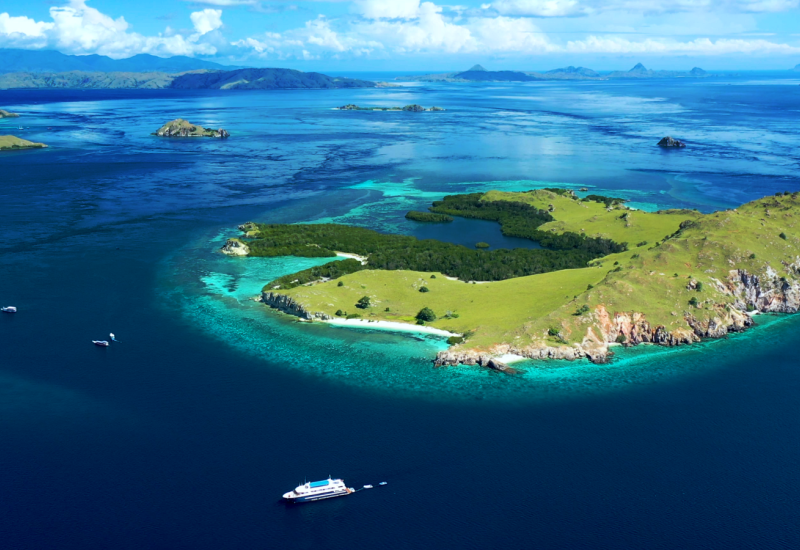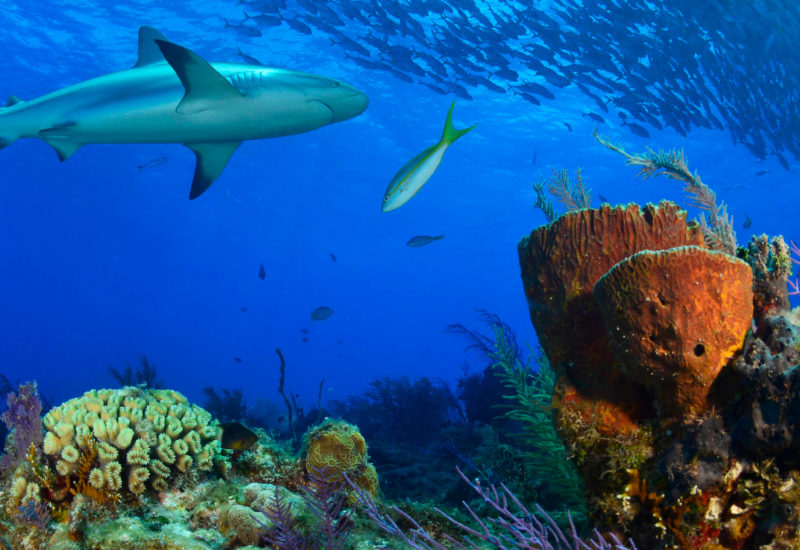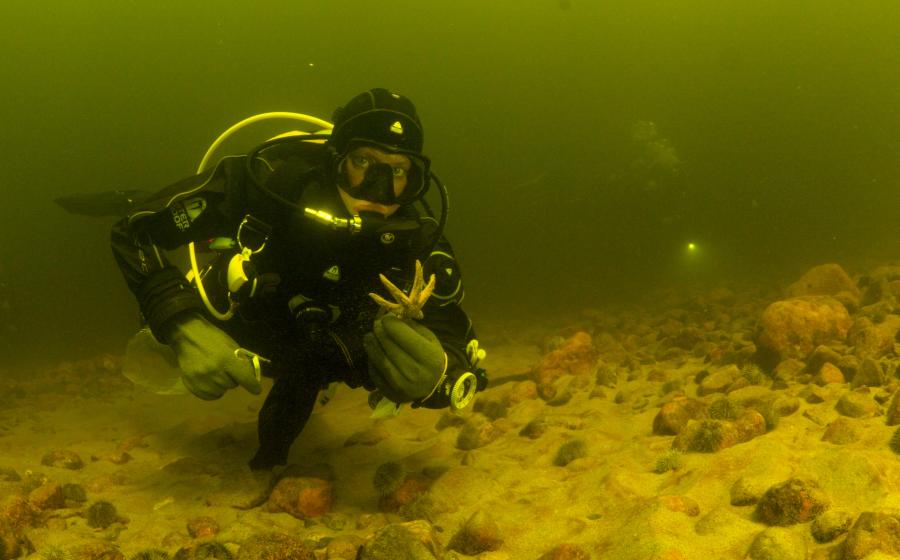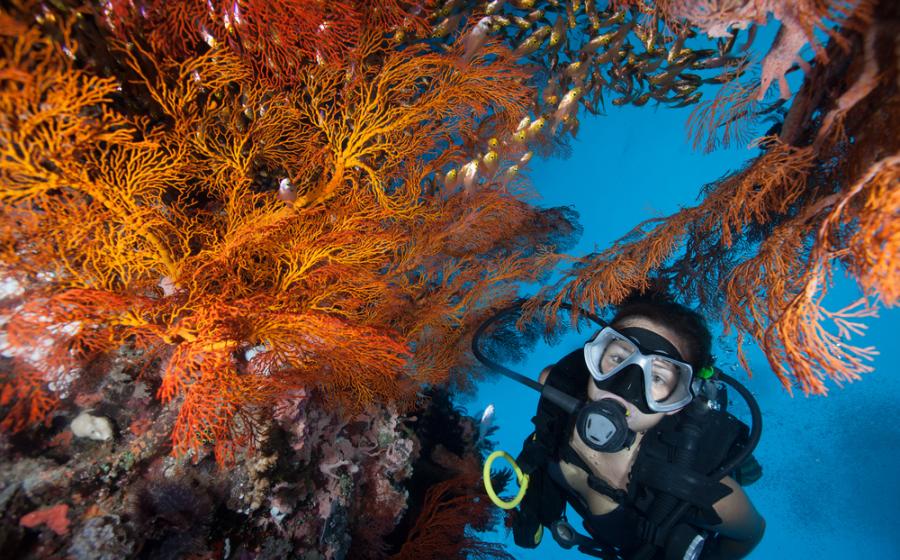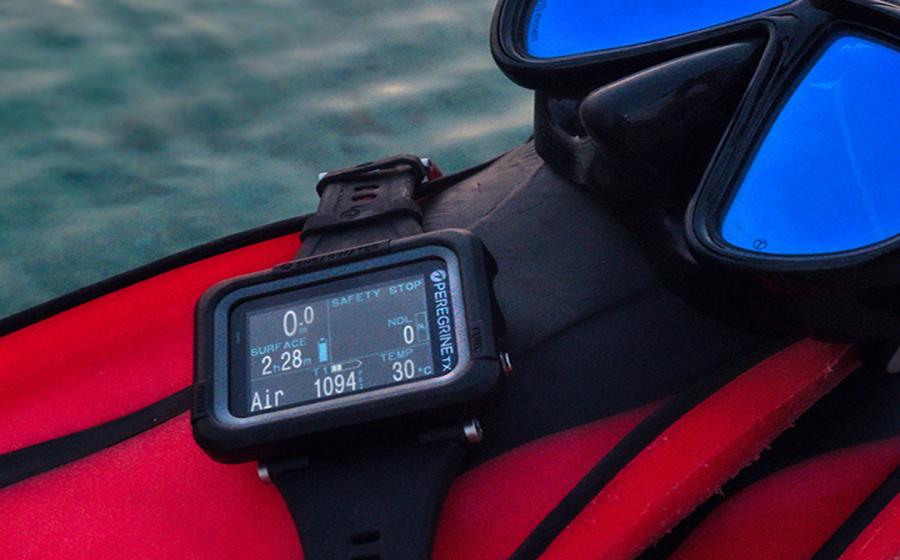Liveaboard: Enchanted Voyage on the Arenui
From the instant we roll off the tenders, the nighttime parade at Cendana Fuel Dock is dazzling: white V octopus, bobtail squid, a freaky school of catfish — its slithering mass an eerie imitation of Voldemort’s Nagini — enormous hunting lionfish, jellies, crabs, shrimp, frogfish, stonefish and an oversize anemone that suddenly jumps up and runs away. (Carrier crab, hilarious.)
And then, the mother lode: a blue-ring octopus.
It’s just hanging out on a flat bit of coral until it gets good and riled, turns an intense mustard-yellow with neon spots, and charges down a hole — an astonishing, if brief, display from such a tiny creature.
Night dives in Indonesia’s Raja Ampat are like that, the black curtain of invisibility pulled back on one wonder after another. But this show isn’t over. We break the silky waters of Aljui Bay under the Milky Way — startlingly close — just as two shooting stars trace bright arcs in the sky.
Nearby, Arenui’s lamps cast a glow across the ripples as the live-aboard rocks ever so slightly at anchor, golden lights beckoning. Greeting us with hot cocoa and a warm scented face cloth — a treat reserved for night divers — the crew rushes to help strip off wet gear and whisks it away, leaving just enough time for a hot shower before a four-course dinner is served al fresco on Arenui’s top-deck Sky Restaurant. For divers, this is bliss.
Arenui bills itself as “The Boutique Liveaboard.” “Italian design and styling with an Indo feeling,” explains Debbie Arriaga, half of Arenui’s husband-and wife cruise-director team. The 141-foot floating work of art displays attention to craft in every facet of the ship, from its recycled-teak Phinisi design — wooden rigged ships of native origin — to the beaten-copper sconces, rattan baskets, silk pillows, heavy crackle-glass pitchers and Bali-made stoneware in the light-filled main salon that doubles as dining hall and everyday hangout.
“Divers are adventurous people,” says Arriaga. “They’re willing to slum it if the diving is good. But why not have luxury and good diving?
”Then there’s the legendary service: “That’s the comment we get more than anything,” Arriaga says.
“I have my own dive guide half the time,” adds guest Stacy Kerkala, a relatively new diver from San Francisco making her first Indo trip. “And I’ve never seen a boat with cabins this big that weren’t the captain’s cabin.”
RAJA AMPAT DIVE GUIDE
“How about a walking shark?”
It’s almost the only thing on my Raja bucket list we haven’t seen — I’m testing our divemasters’ ability to deliver whatever critter I name, virtually instantly. We haven’t seen a single one of these, and our trip is drawing to an end. I’ve got her stumped. Or not.
With a wicked gleam and a grin that’s about to bust the confines of her mask, Arriaga is frantically wiggling her light to draw my attention just after we descend on a night dive at Dampier Strait’s Arborek Jetty. Scrambling to grasp what she’s telling me — what? already?! — I see the elusive, leopard-spotted shark scuttle under a coral head, where we circle awhile, admiring the brief glimpses it allows us.
Descending right on top of a shark isn’t that uncommon in Raja Ampat, where the wildlife takes a largely laissez-faire attitude toward divers: We won’t worry about you if you don’t worry us. We drop in on the neighbors again at Dampier Strait’s Manta Sandy — a hugely popular site I fear won’t deliver for precisely that reason. But the mantas are there, sweeping over and around our heads for what seems like hours, peering intently at each diver with clear intelligence, undisturbed by our presence.
That’s one of Raja’s great attractions, and one that has helped keep it a primordial paradise: By rat-race standards, there’s nobody out here. Human pressures are delightfully few compared with most places you can dive.
The region of Indonesia known as Raja Ampat stretches from Sorong — a common live-aboard embarkation point on the tip of Papua’s Bird’s Head peninsula — beyond palm-fringed Wayag in the north, comprising four large islands and 1,500 islets. Waters are warm — a 3 mm fullsuit with a hooded vest and rash guards to doff or don for night dives was just fine in February — and while currents can run to thrilling extremes, that’s not the norm. (Although take your divemaster seriously when he calls for a quick negative descent.) Paying attention to briefings is key — current might be mild where you descend, but pass the tip of that reef, and it’s suddenly a different ride entirely.
For many divers, the main draw in Raja — one of the world’s undisputed, off-the-charts centers of biodiversity — is the critters, many of which are found almost nowhere else. At Dampier Strait’s Mioskon Island, we come upon mating wobbegongs with huge engorged claspers and shy giant clams that snap shut at our approach, the patterning and colors of each as rich and intricate as batik.
For other divers, it’s the animals that can’t get away from you that are the draw: Corals hard and soft are abundant and healthy here. At Takat Penemu in Raja’s Fam Islands, fully inflated miniature “trees” of white soft corals are like little dogwoods; I half expected to see blossoms raining down on the good-size wobbe cradled in gently cupped coral, like a Labrador snuggled in its favorite doggie bed.
“Coral garden” gets tossed around a lot in the dive world — you’ll think differently about that phrase after you dive Raja’s undisturbed acres, like the black coral — in white, tan, peach and umber — that stretches as far as the eye can see at Wofoh Black Forest, another gorgeous site off Waigeo Island.
And so the days roll one into another, each sunset more spectacular than the night before, as you try to forget that, eventually, you’re going to have to get off this ship you’ve come to think of as home. How many times can you write “Holy cow!” in a dive-log entry? About as often as you can dive, which on Arenui is usually four times a day. Lying on my back at Takat Yangello North, near the island of Gam, I watch millions and millions of baitfish — so densely packed that I cannot see though them — form a living cyclone that seems to reach all the way to the sunny surface, and I can’t stop smiling.
It just doesn’t get any better than this.
NEED TO KNOW
>>When to go: Arenui (thearenui.com) spends May to October around Komodo National Park, diving Bali to Flores and Alor. In November it heads toward Ambon and the Spice Islands, then to Raja Ampat from December through April.
>>Dive Conditions: Raja currents can be gentle to strong – pay attention to your briefings. Depths range from 30 to 100 feet. Conditions December through April generally are calm, but final itineraries are always dictated by the captain’s reading of local conditions. Visibility ranges from 30 to 115 feet, and water temps from 80 to 88 degrees F.
>>Operator: With only eight cabins – all with private bathrooms – and a maximum of 16 passengers to its 22 crew (including three captains, three chefs and five dive guides), Arenui maintains a superior level of service. Meals are often gourmet and are more or less constant. Diving is done from expertly handled tenders that seem to materialize instantly whenever you surface.
>>Price Tag: An 11-night Raja cruise with up to four dives daily starts at $5,280 per person.
5 REASONS TO DIVE RAJA AMPAT ABOARD ARENUI
TIME TRAVEL From undersea kingdoms ruled by giant mantas to blinding-white cockatoos dotting curtains of green in every bay, you'll constantly think: This is what Eath looked like when the world was new.
CRITTER SPOTTING You'll knock off a lot of that life list in Raja Ampat, guaranteed. And you'll swear your dive guides have magical powers (or maybe it's their more than 75 years combinded dive experience).
CONSTANT BEAUTY Everywhere you cast your eyes -- from boat to waves to shore -- you'll be in awe of the natural and artistic beauty that surrounds you.
SPOILED, SPOILED, SPOILED Sure, luxury service can be found the world over, but rarely does a staff make you truly believe they are living the night through just to make you smile each morning.
NOTHING WHATSOEVER Sitting on the top deck just after dawn with a cup of coffee, your dive log and a stack of critter guides, watching Raja glide by. Kill me now.
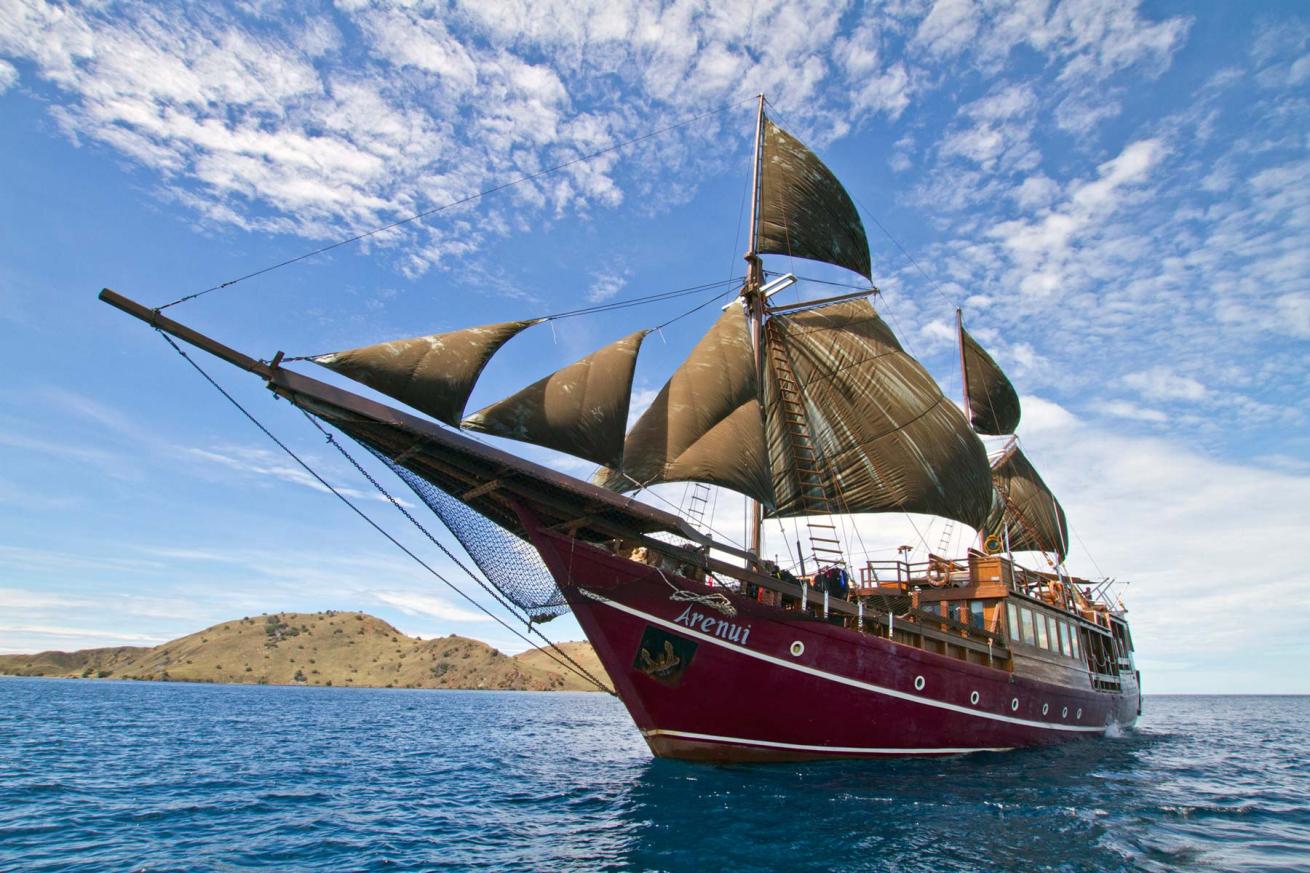
Courtesy of the ArenuiIt will be love at first sight when you first see Arenui.
From the instant we roll off the tenders, the nighttime parade at Cendana Fuel Dock is dazzling: white V octopus, bobtail squid, a freaky school of catfish — its slithering mass an eerie imitation of Voldemort’s Nagini — enormous hunting lionfish, jellies, crabs, shrimp, frogfish, stonefish and an oversize anemone that suddenly jumps up and runs away. (Carrier crab, hilarious.)
And then, the mother lode: a blue-ring octopus.
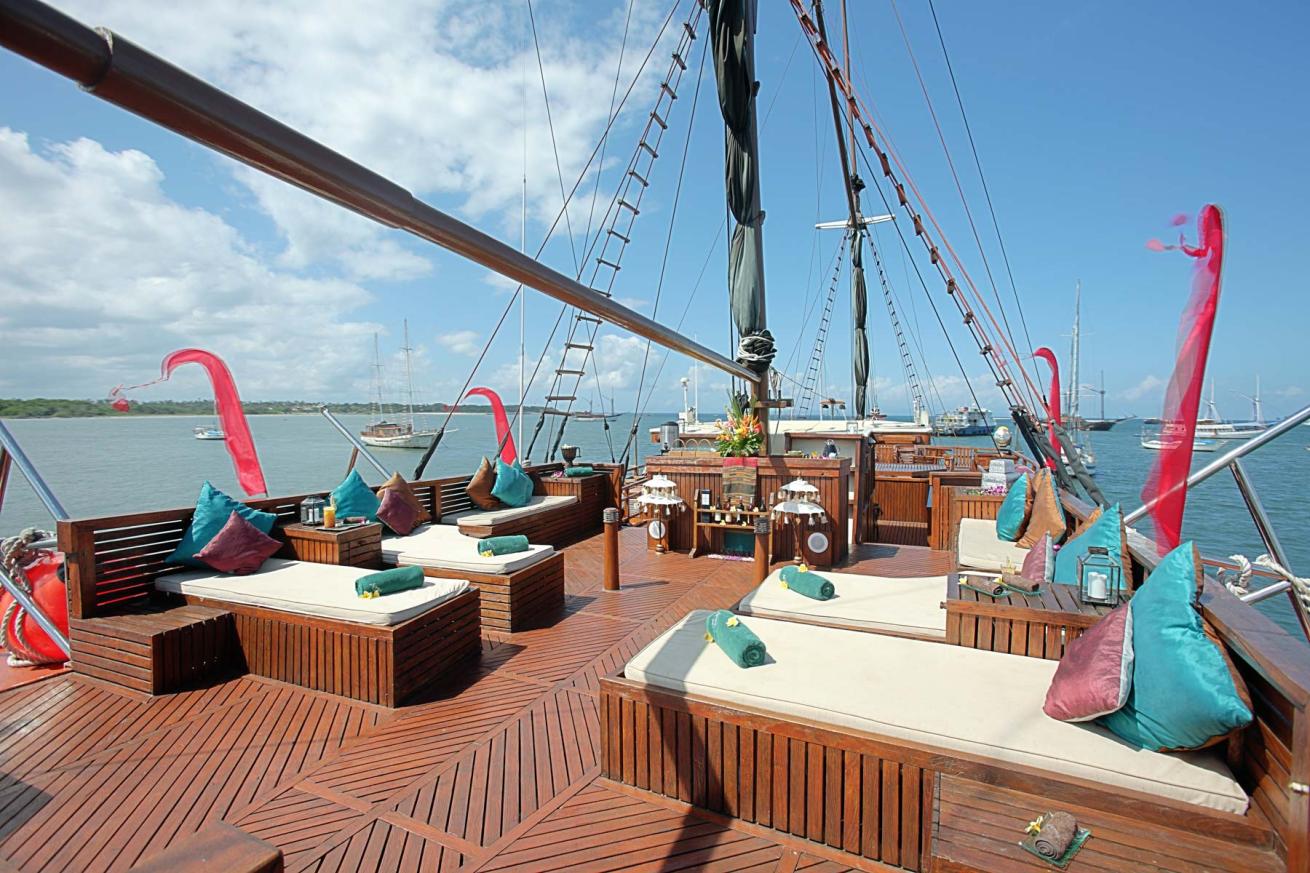
Courtesy of the ArenuiArenui's sky deck is a wonderful place to unwind.
It’s just hanging out on a flat bit of coral until it gets good and riled, turns an intense mustard-yellow with neon spots, and charges down a hole — an astonishing, if brief, display from such a tiny creature.
Night dives in Indonesia’s Raja Ampat are like that, the black curtain of invisibility pulled back on one wonder after another. But this show isn’t over. We break the silky waters of Aljui Bay under the Milky Way — startlingly close — just as two shooting stars trace bright arcs in the sky.
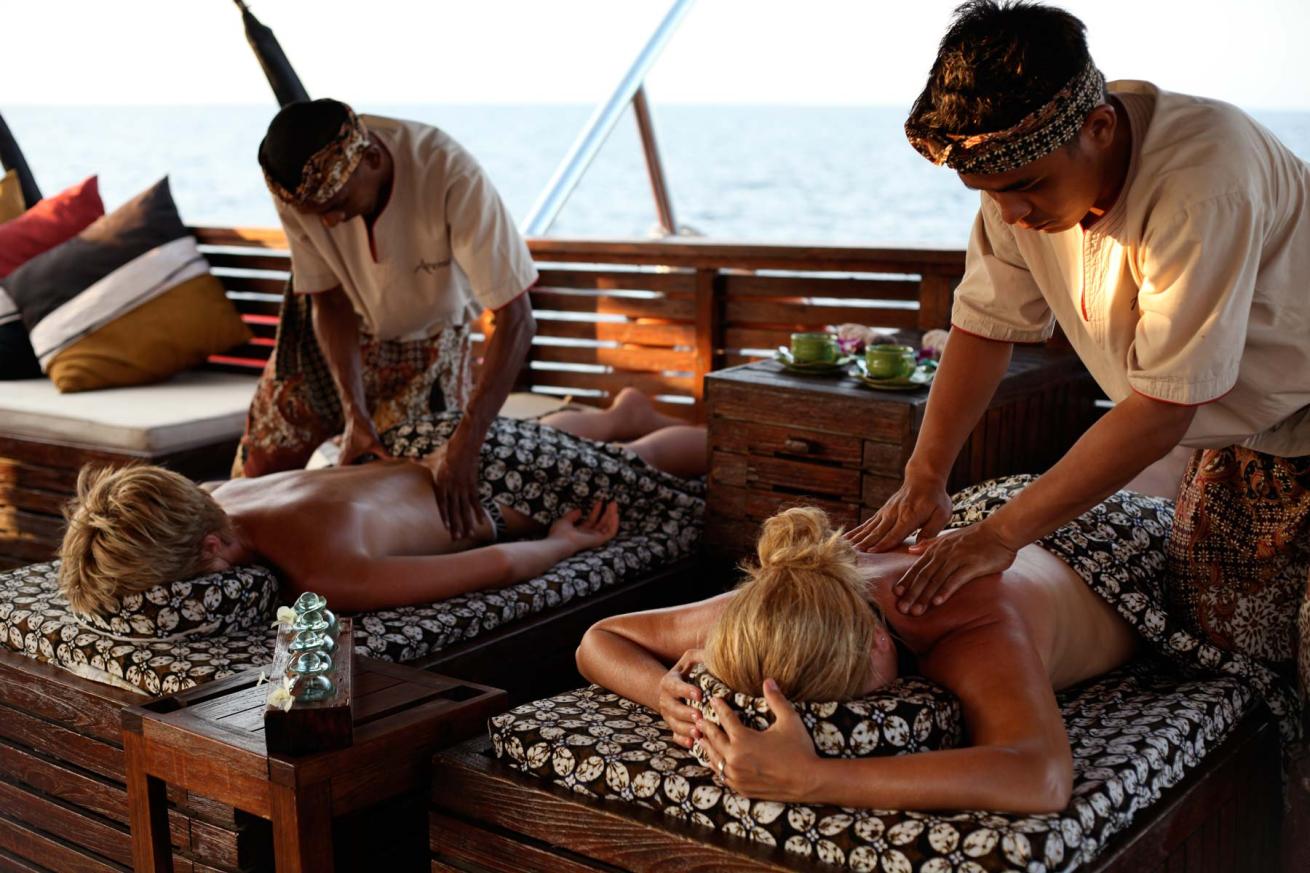
Courtesy of the ArenuiWhy not indulge??? You're on vacation!
Nearby, Arenui’s lamps cast a glow across the ripples as the live-aboard rocks ever so slightly at anchor, golden lights beckoning. Greeting us with hot cocoa and a warm scented face cloth — a treat reserved for night divers — the crew rushes to help strip off wet gear and whisks it away, leaving just enough time for a hot shower before a four-course dinner is served al fresco on Arenui’s top-deck Sky Restaurant. For divers, this is bliss.
Arenui bills itself as “The Boutique Liveaboard.” “Italian design and styling with an Indo feeling,” explains Debbie Arriaga, half of Arenui’s husband-and wife cruise-director team. The 141-foot floating work of art displays attention to craft in every facet of the ship, from its recycled-teak Phinisi design — wooden rigged ships of native origin — to the beaten-copper sconces, rattan baskets, silk pillows, heavy crackle-glass pitchers and Bali-made stoneware in the light-filled main salon that doubles as dining hall and everyday hangout.
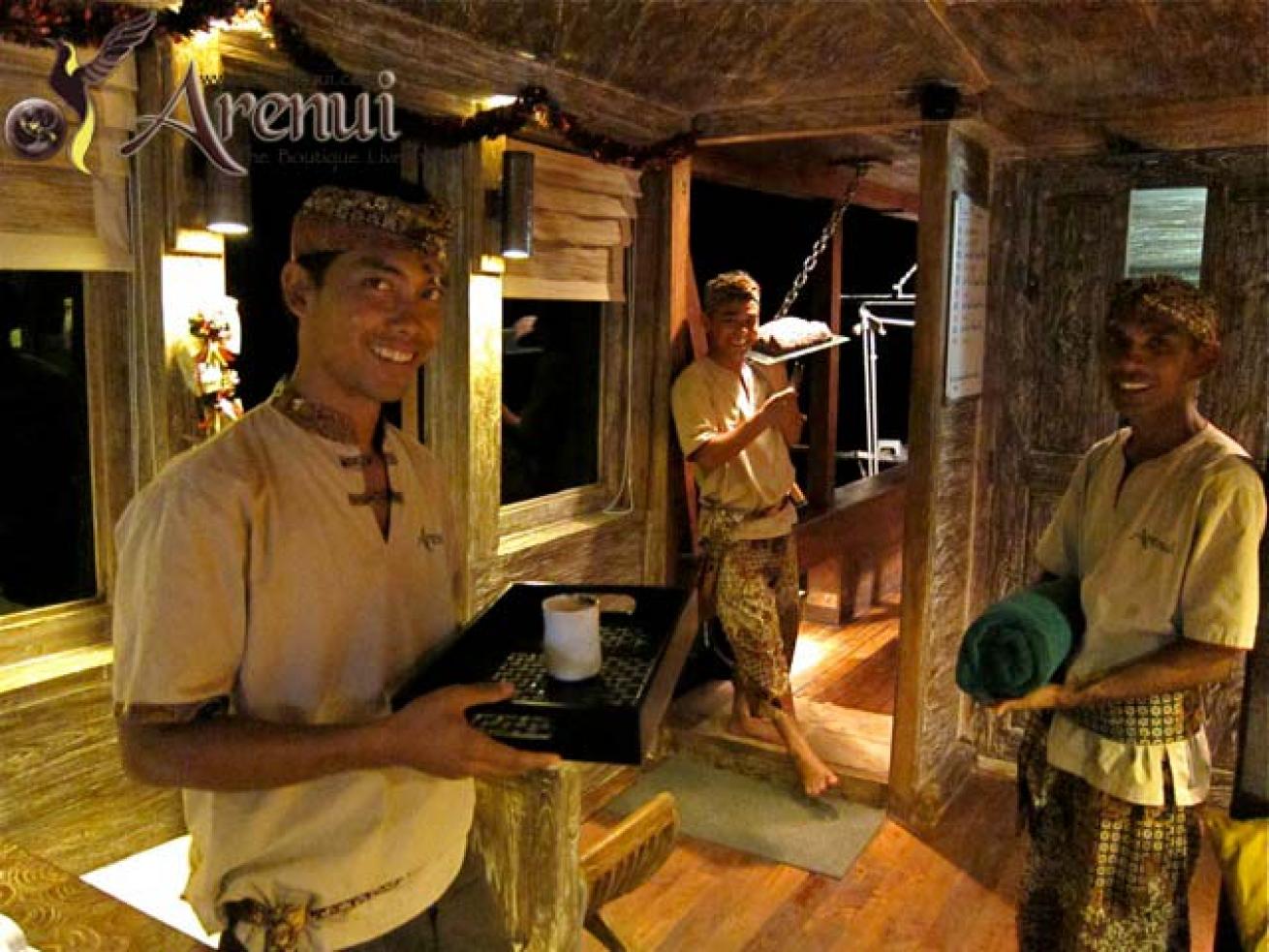
Courtesy of the ArenuiGet used to being pampered by Arenui's crew.
“Divers are adventurous people,” says Arriaga. “They’re willing to slum it if the diving is good. But why not have luxury and good diving?
”Then there’s the legendary service: “That’s the comment we get more than anything,” Arriaga says.
“I have my own dive guide half the time,” adds guest Stacy Kerkala, a relatively new diver from San Francisco making her first Indo trip. “And I’ve never seen a boat with cabins this big that weren’t the captain’s cabin.”
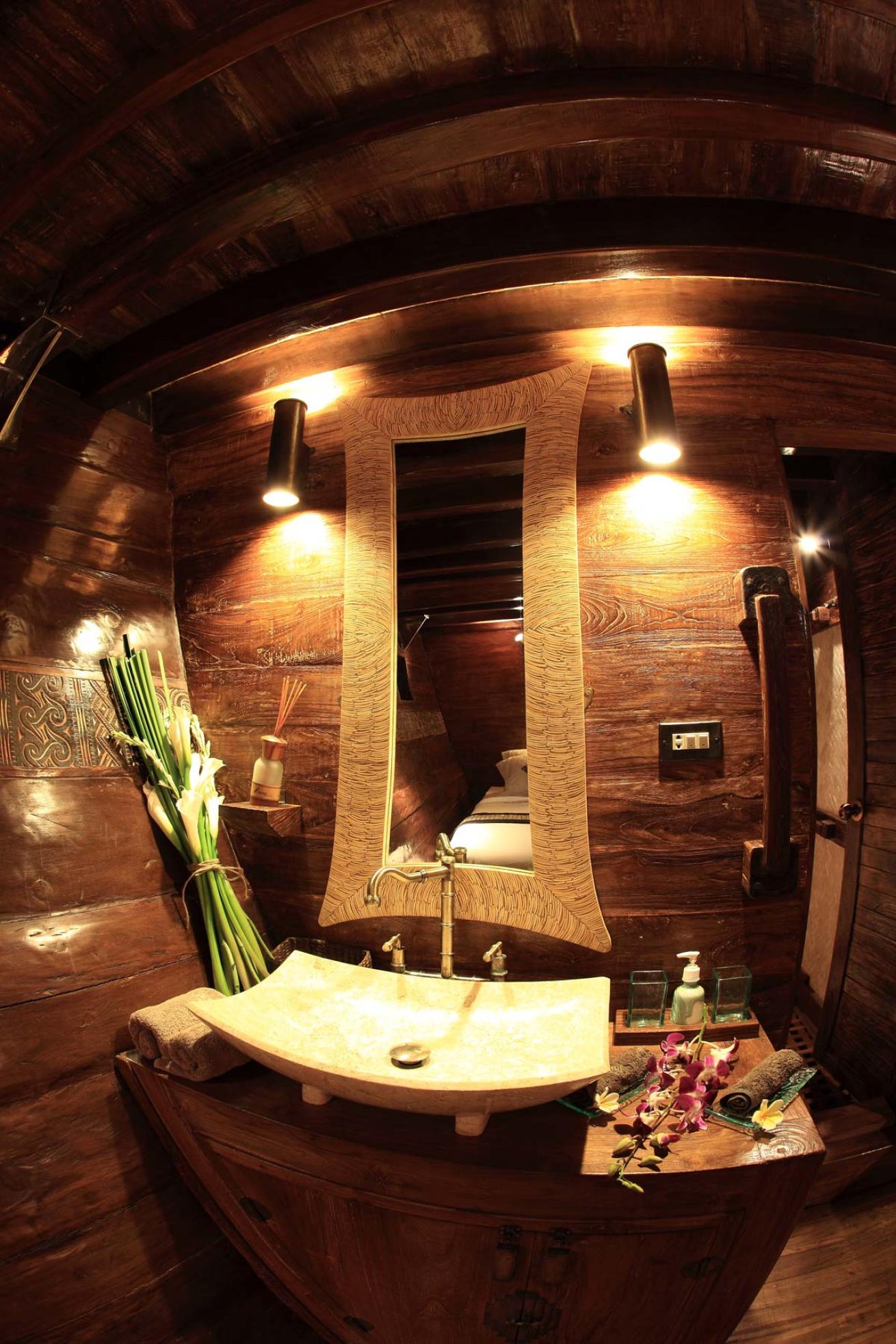
Courtesy of the ArenuiOne of the en suite bathrooms.
RAJA AMPAT DIVE GUIDE
“How about a walking shark?”
It’s almost the only thing on my Raja bucket list we haven’t seen — I’m testing our divemasters’ ability to deliver whatever critter I name, virtually instantly. We haven’t seen a single one of these, and our trip is drawing to an end. I’ve got her stumped. Or not.
With a wicked gleam and a grin that’s about to bust the confines of her mask, Arriaga is frantically wiggling her light to draw my attention just after we descend on a night dive at Dampier Strait’s Arborek Jetty. Scrambling to grasp what she’s telling me — what? already?! — I see the elusive, leopard-spotted shark scuttle under a coral head, where we circle awhile, admiring the brief glimpses it allows us.
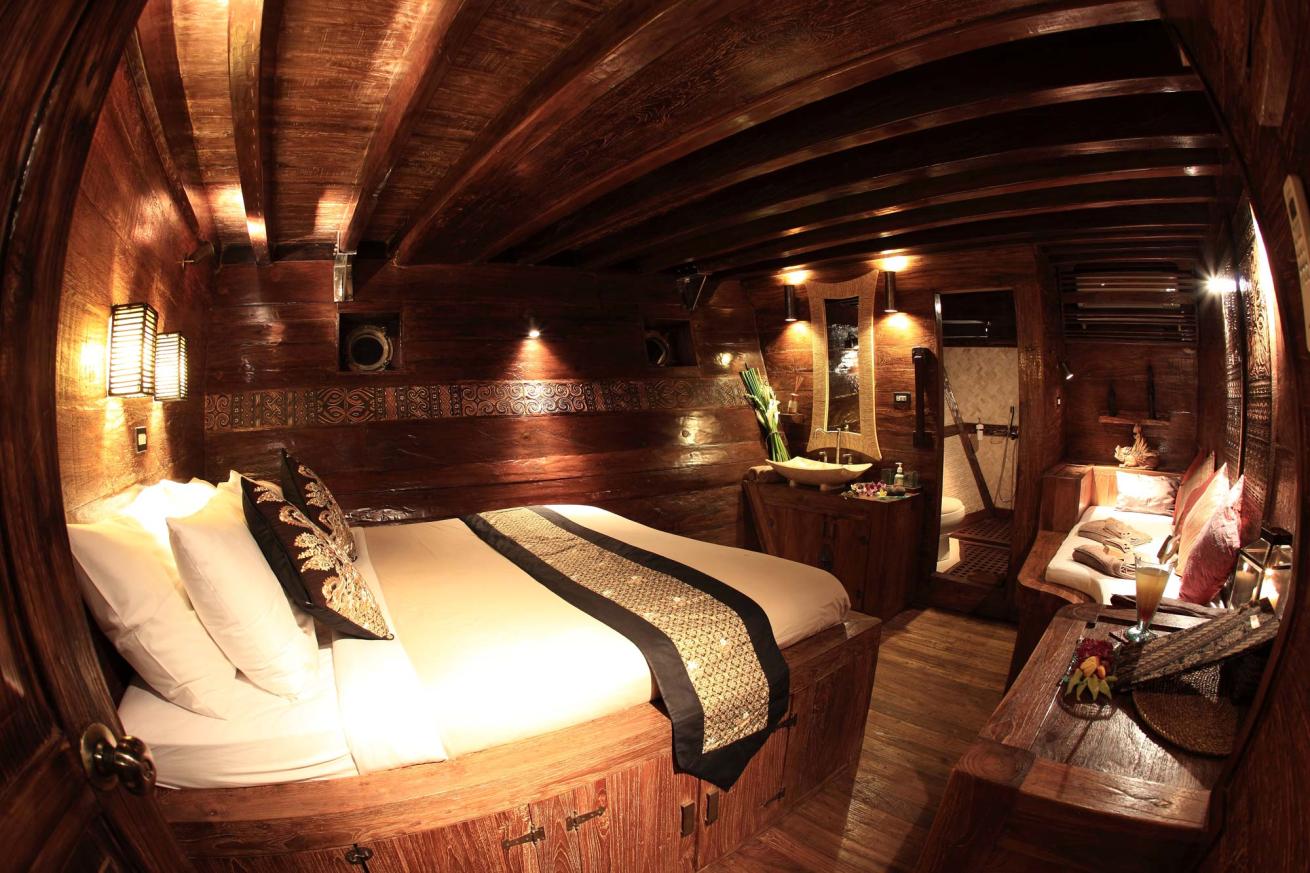
Courtesy of the ArenuiLovely attention to detail characterizes the Arenui.
Descending right on top of a shark isn’t that uncommon in Raja Ampat, where the wildlife takes a largely laissez-faire attitude toward divers: We won’t worry about you if you don’t worry us. We drop in on the neighbors again at Dampier Strait’s Manta Sandy — a hugely popular site I fear won’t deliver for precisely that reason. But the mantas are there, sweeping over and around our heads for what seems like hours, peering intently at each diver with clear intelligence, undisturbed by our presence.
That’s one of Raja’s great attractions, and one that has helped keep it a primordial paradise: By rat-race standards, there’s nobody out here. Human pressures are delightfully few compared with most places you can dive.
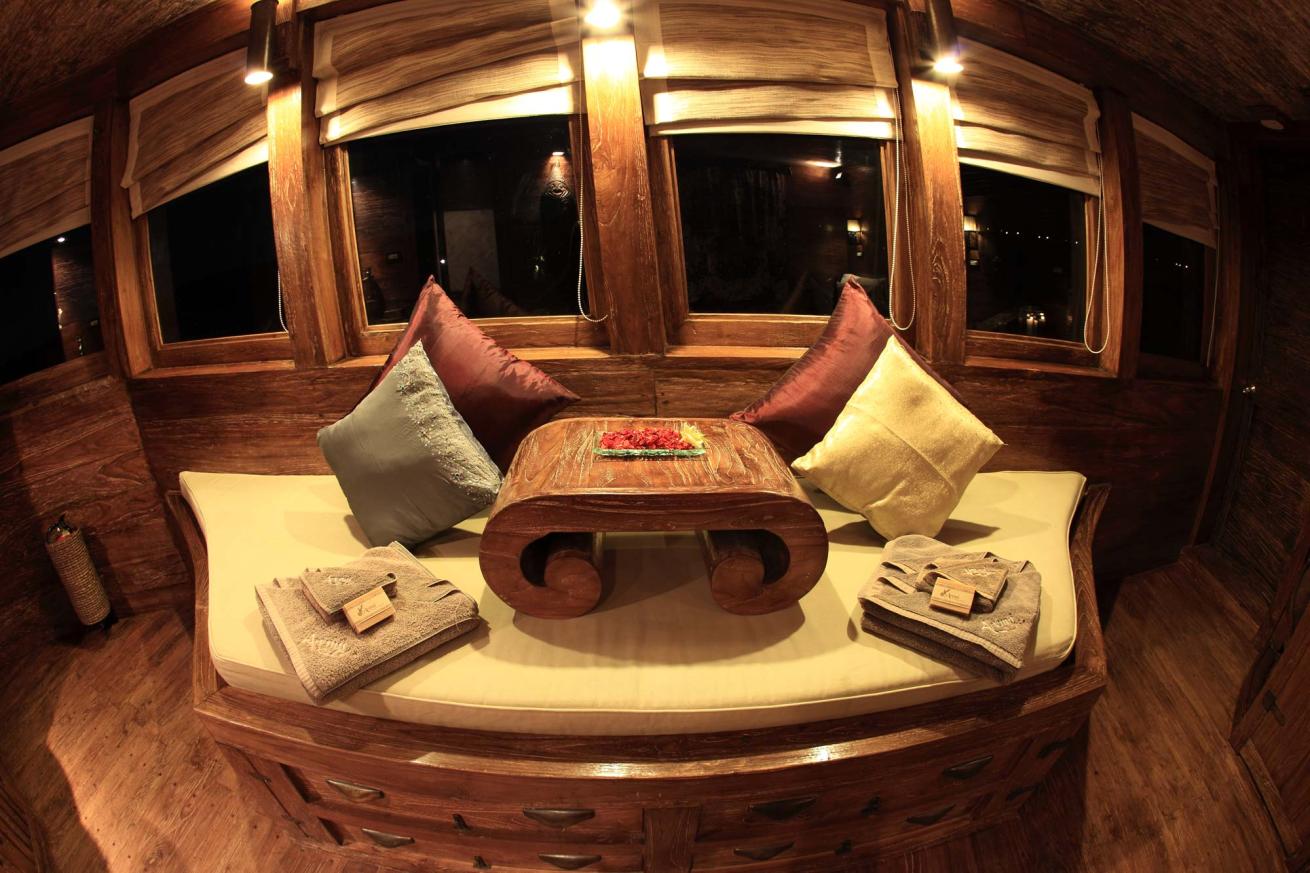
.
The region of Indonesia known as Raja Ampat stretches from Sorong — a common live-aboard embarkation point on the tip of Papua’s Bird’s Head peninsula — beyond palm-fringed Wayag in the north, comprising four large islands and 1,500 islets. Waters are warm — a 3 mm fullsuit with a hooded vest and rash guards to doff or don for night dives was just fine in February — and while currents can run to thrilling extremes, that’s not the norm. (Although take your divemaster seriously when he calls for a quick negative descent.) Paying attention to briefings is key — current might be mild where you descend, but pass the tip of that reef, and it’s suddenly a different ride entirely.
For many divers, the main draw in Raja — one of the world’s undisputed, off-the-charts centers of biodiversity — is the critters, many of which are found almost nowhere else. At Dampier Strait’s Mioskon Island, we come upon mating wobbegongs with huge engorged claspers and shy giant clams that snap shut at our approach, the patterning and colors of each as rich and intricate as batik.
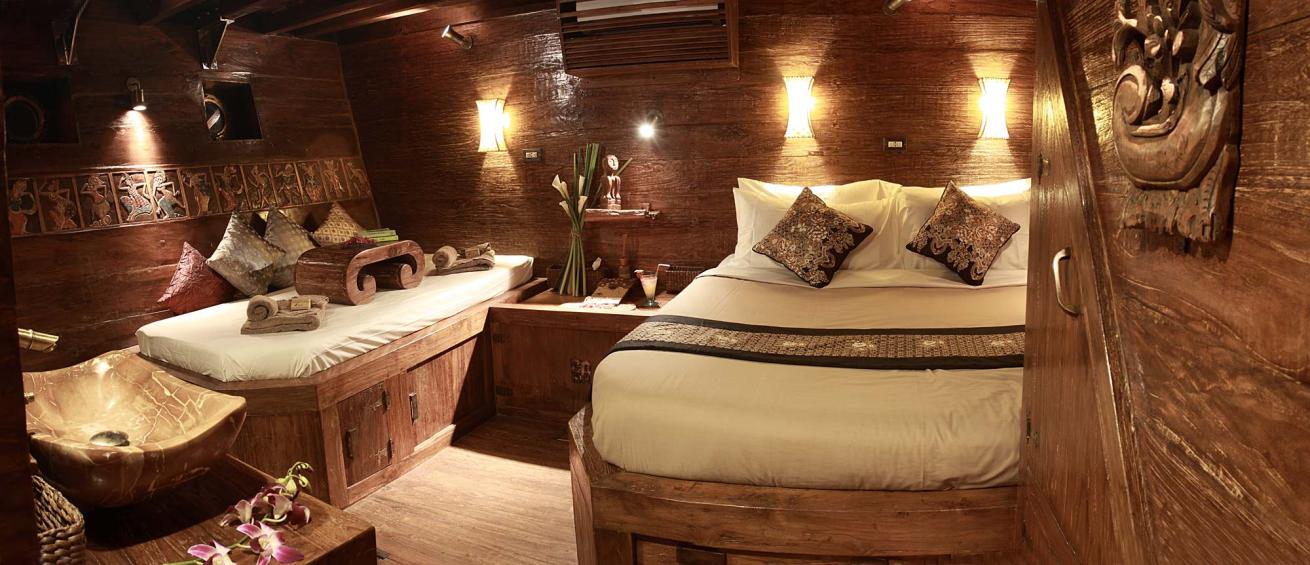
.The luxury onboard the Arenui is evident everywhere.
For other divers, it’s the animals that can’t get away from you that are the draw: Corals hard and soft are abundant and healthy here. At Takat Penemu in Raja’s Fam Islands, fully inflated miniature “trees” of white soft corals are like little dogwoods; I half expected to see blossoms raining down on the good-size wobbe cradled in gently cupped coral, like a Labrador snuggled in its favorite doggie bed.
“Coral garden” gets tossed around a lot in the dive world — you’ll think differently about that phrase after you dive Raja’s undisturbed acres, like the black coral — in white, tan, peach and umber — that stretches as far as the eye can see at Wofoh Black Forest, another gorgeous site off Waigeo Island.
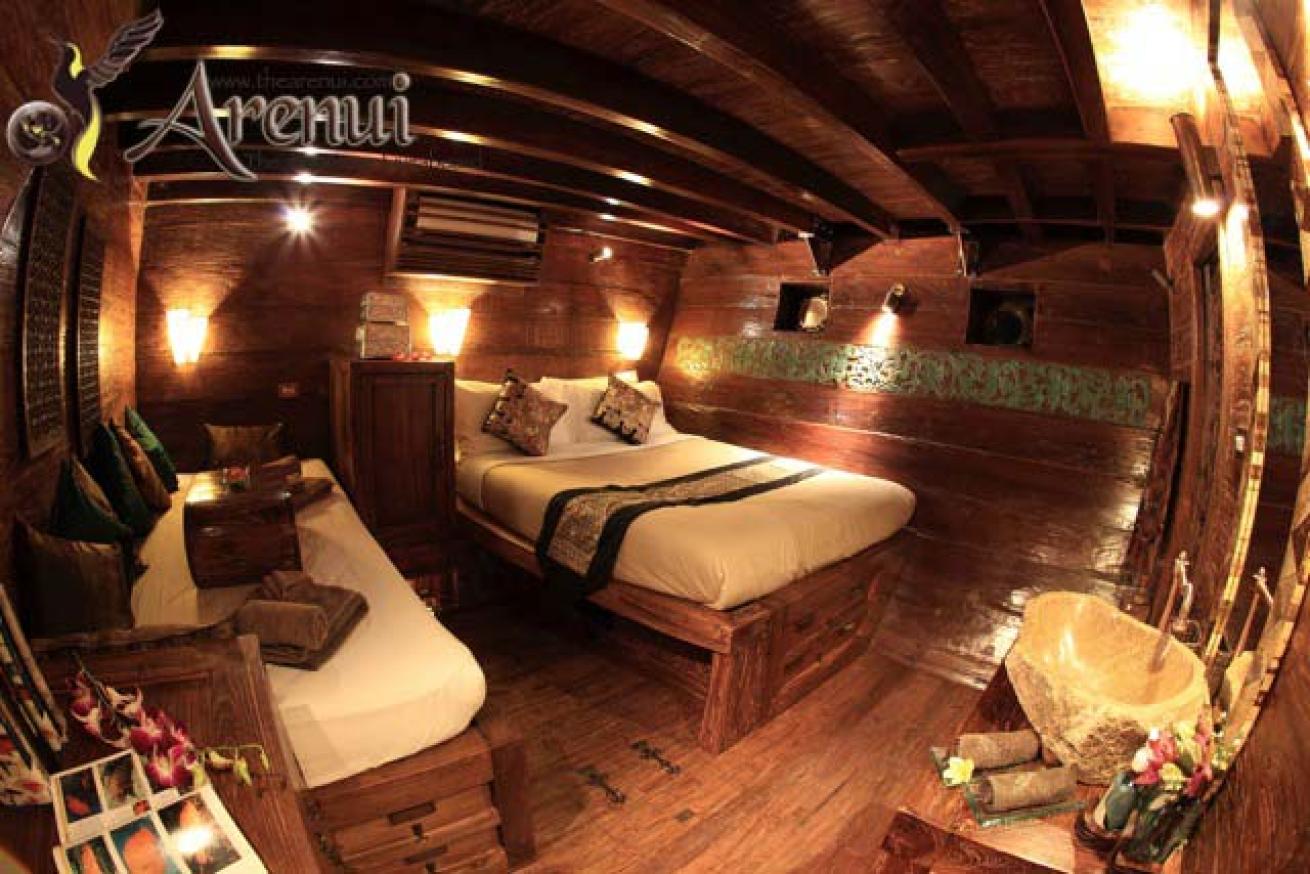
.One of the Arenui's cabin configurations.
And so the days roll one into another, each sunset more spectacular than the night before, as you try to forget that, eventually, you’re going to have to get off this ship you’ve come to think of as home. How many times can you write “Holy cow!” in a dive-log entry? About as often as you can dive, which on Arenui is usually four times a day. Lying on my back at Takat Yangello North, near the island of Gam, I watch millions and millions of baitfish — so densely packed that I cannot see though them — form a living cyclone that seems to reach all the way to the sunny surface, and I can’t stop smiling.
It just doesn’t get any better than this.
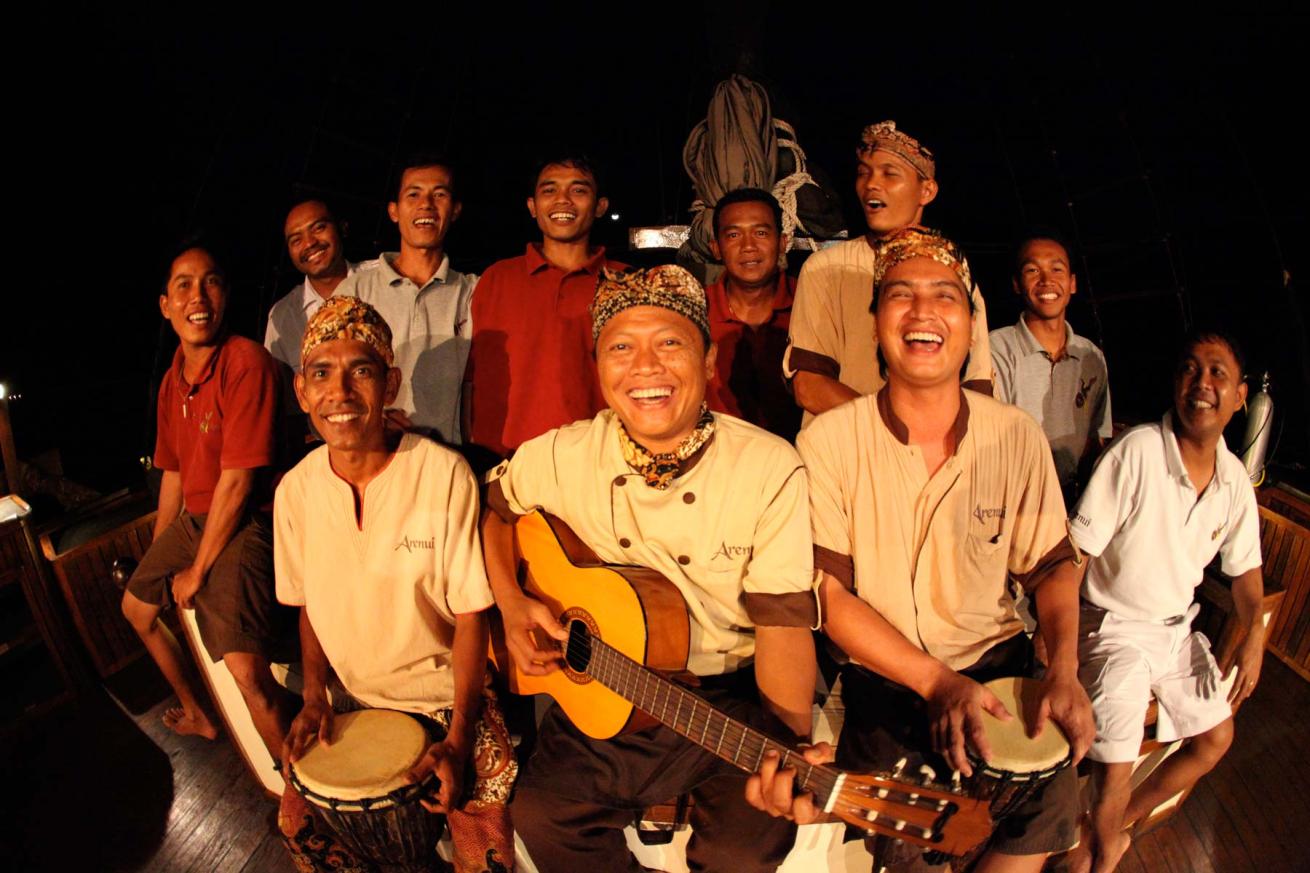
.The Arenui crew entertains the guests.
NEED TO KNOW
>>When to go: Arenui (thearenui.com) spends May to October around Komodo National Park, diving Bali to Flores and Alor. In November it heads toward Ambon and the Spice Islands, then to Raja Ampat from December through April.
>>Dive Conditions: Raja currents can be gentle to strong – pay attention to your briefings. Depths range from 30 to 100 feet. Conditions December through April generally are calm, but final itineraries are always dictated by the captain’s reading of local conditions. Visibility ranges from 30 to 115 feet, and water temps from 80 to 88 degrees F.
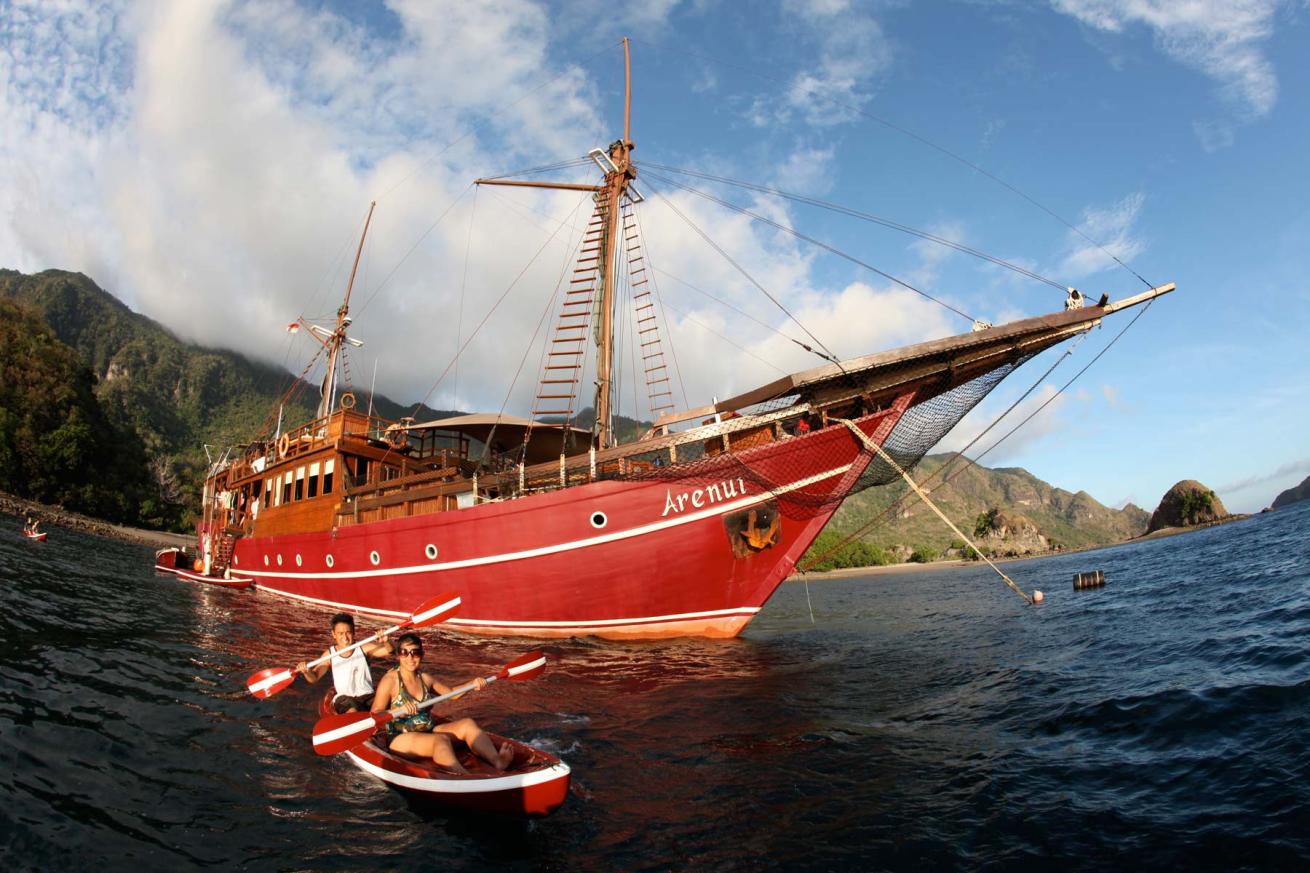
.Take one of the onboard kayaks to explore during your surface interval/
>>Operator: With only eight cabins – all with private bathrooms – and a maximum of 16 passengers to its 22 crew (including three captains, three chefs and five dive guides), Arenui maintains a superior level of service. Meals are often gourmet and are more or less constant. Diving is done from expertly handled tenders that seem to materialize instantly whenever you surface.
>>Price Tag: An 11-night Raja cruise with up to four dives daily starts at $5,280 per person.
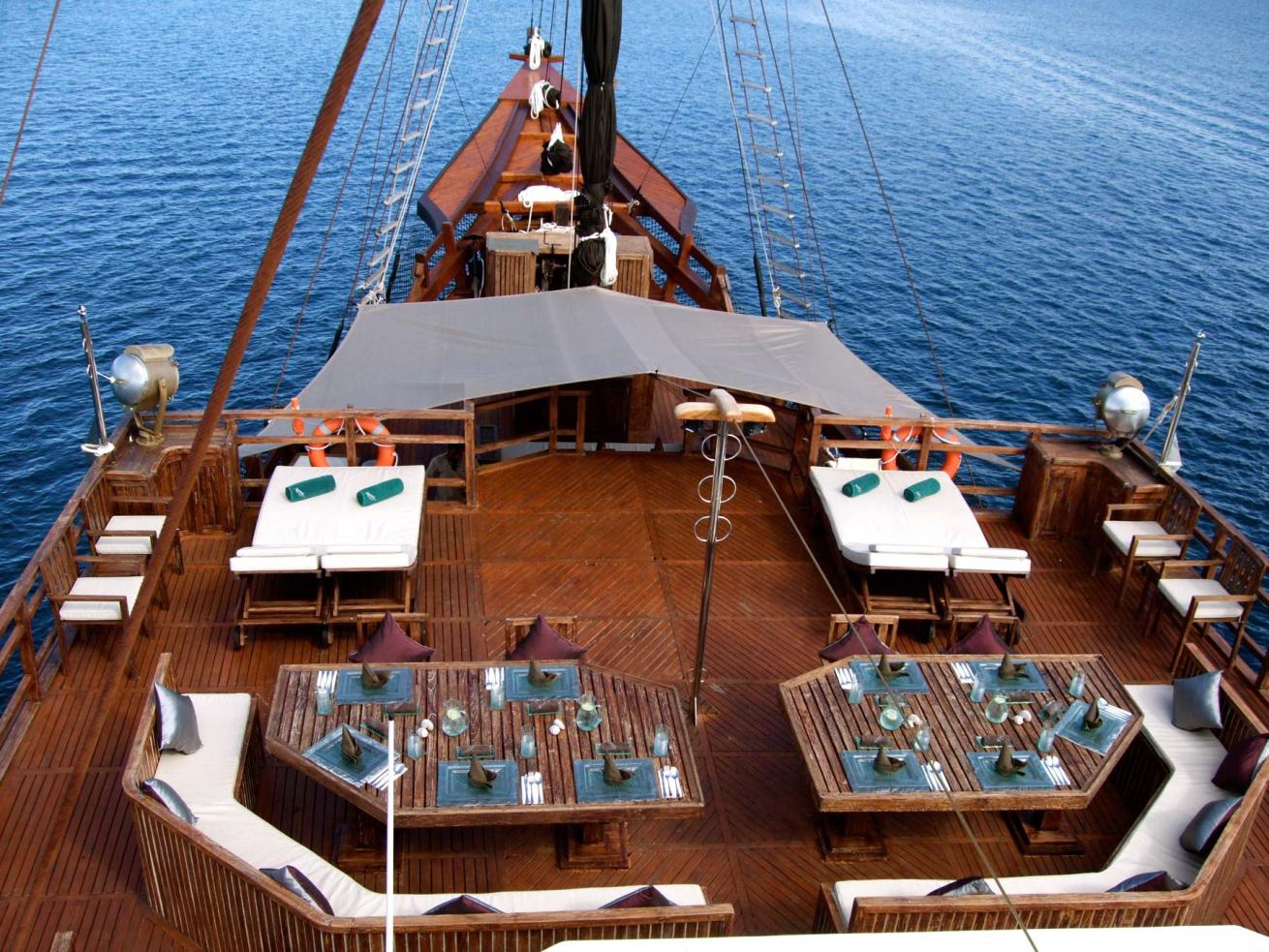
.There's plenty of space to take a nap, read a book or enjoy the views from Arenui's sky deck.
5 REASONS TO DIVE RAJA AMPAT ABOARD ARENUI
TIME TRAVEL From undersea kingdoms ruled by giant mantas to blinding-white cockatoos dotting curtains of green in every bay, you'll constantly think: This is what Eath looked like when the world was new.
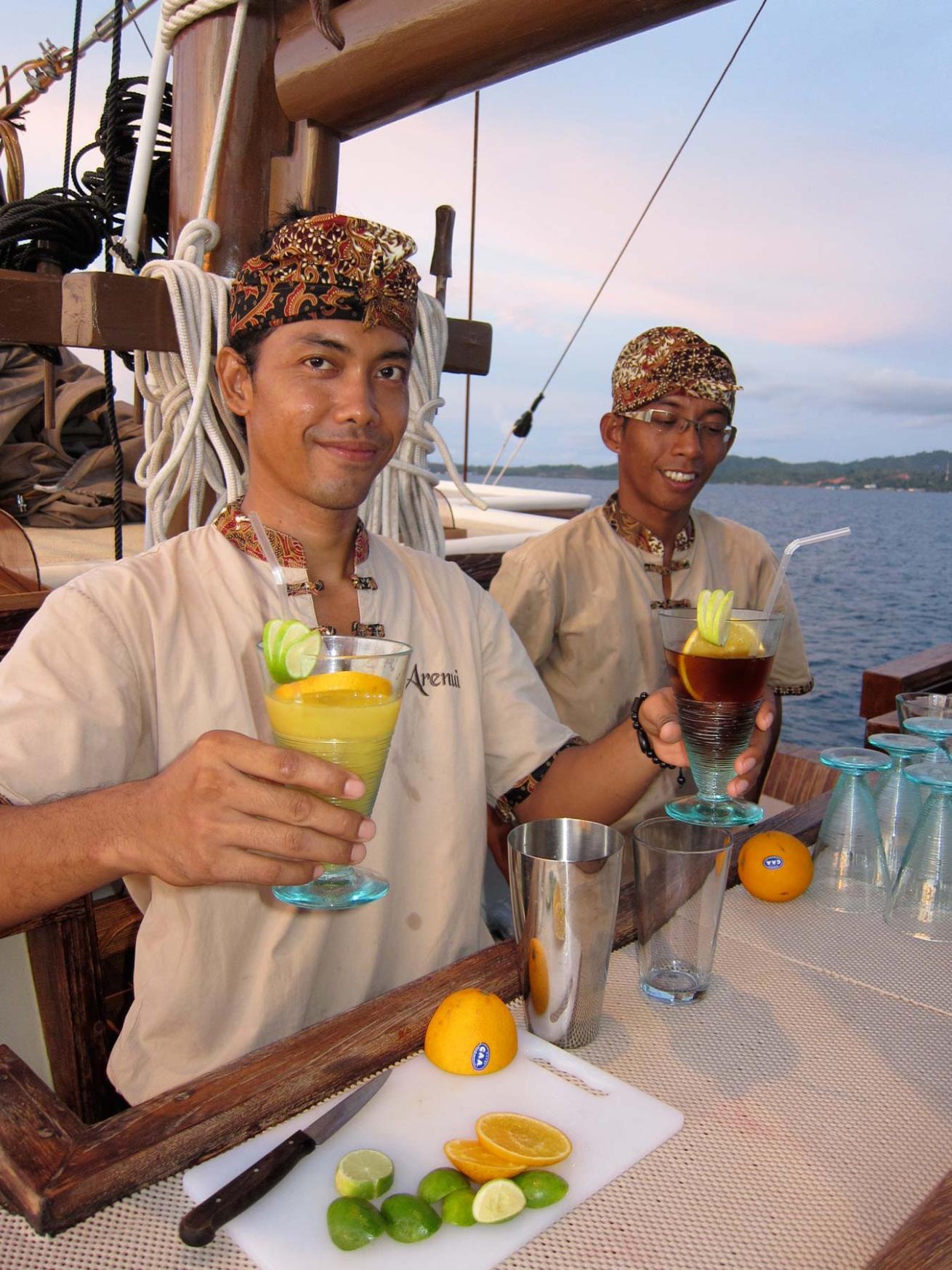
.After the diving is done, relax with a drink served by the friendly and helpful staff.
CRITTER SPOTTING You'll knock off a lot of that life list in Raja Ampat, guaranteed. And you'll swear your dive guides have magical powers (or maybe it's their more than 75 years combinded dive experience).
CONSTANT BEAUTY Everywhere you cast your eyes -- from boat to waves to shore -- you'll be in awe of the natural and artistic beauty that surrounds you.
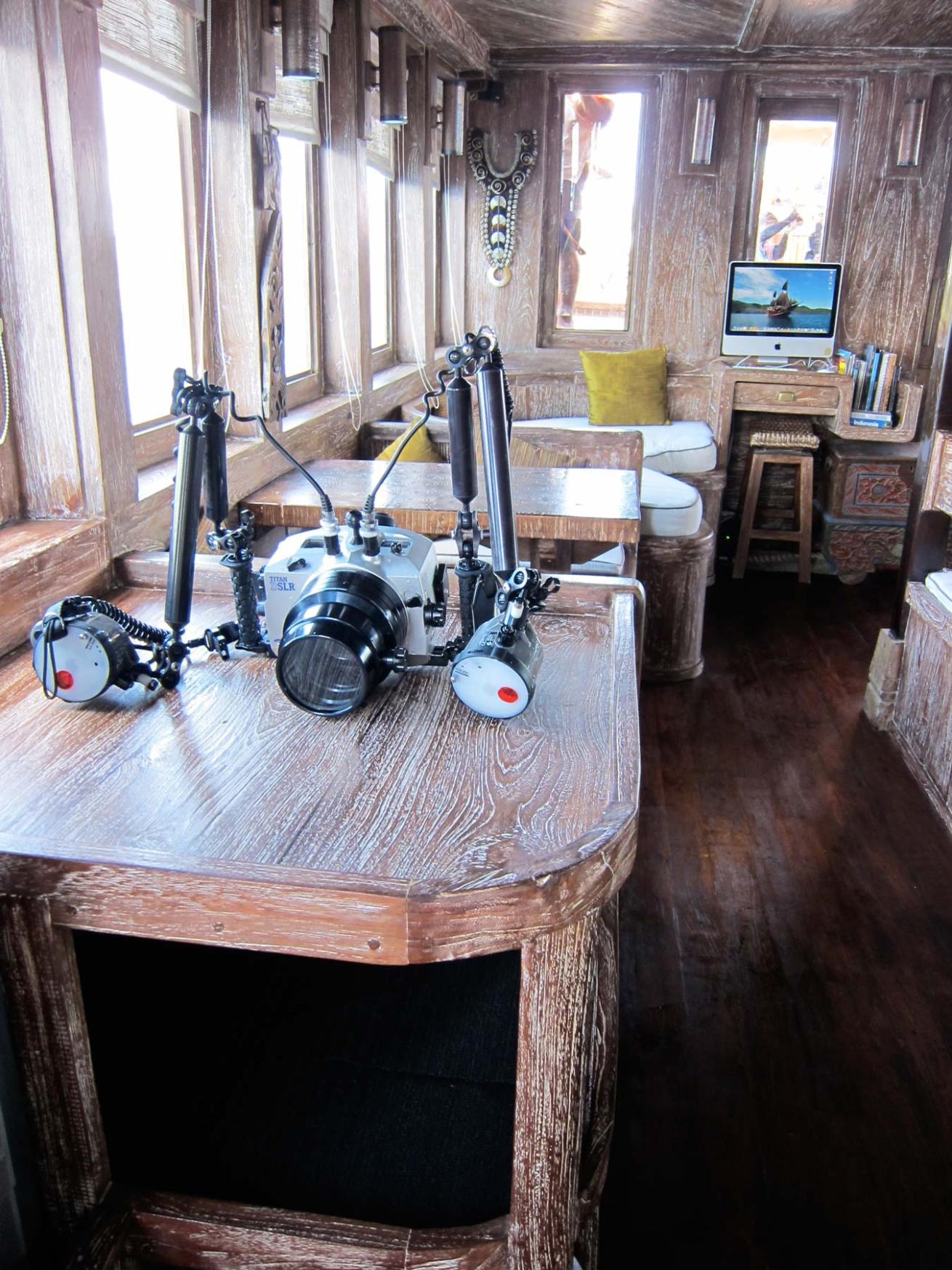
.The Arenui is well equipped for handling the needs of onboard photographers.
SPOILED, SPOILED, SPOILED Sure, luxury service can be found the world over, but rarely does a staff make you truly believe they are living the night through just to make you smile each morning.
NOTHING WHATSOEVER Sitting on the top deck just after dawn with a cup of coffee, your dive log and a stack of critter guides, watching Raja glide by. Kill me now.



